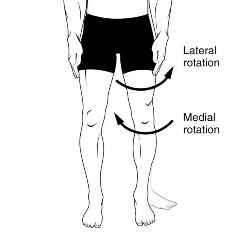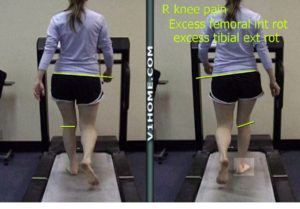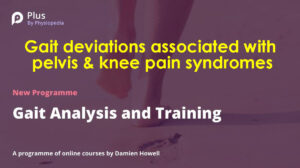Knee Pain Wringing Out – Gait Deviation

Knee pain can develop because of a “wringing out”. I am not referring to banging a bell ring, but the counter-rotation motion that can occur at the knee joint. The knee joint consisting of the thigh and lower leg moves on three different planes of motion. The knee can flex and extend. The knee can move from side to side in medial lateral direction (varus or valgus). The knee can rotate medially and laterally along the long axis of the leg towards or away from the midline of the body.

Normally there is coordinated rotating movement between the thigh and lower leg rotating the same direction at the same time. However there are times when thigh rotates independently from the lower leg counter rotating opposite directions. This counter-rotating movement can be beneficial, or this counter rotating movement can be problematic causing a winging out of the knee joint. This is analogous to wringing water out of a wash cloth. If the wringing out of the knee is excessive it can lead to patella femoral arthralgia (chondromalacia), patellar tendon problems, wear and tear of knee cartilage and IT band syndrome.
Pain occurs either when there is not enough motion or too much motion. Pain related to wringing out of the knee is a situation when there is too much movement. The thigh is rotating too much in a medial direction. The lower leg is rotating too much in a lateral direction.
To perform self-assessment to determine if there is a wringing out contributing to your knee pain is challenging. It requires visualizing wringing out motion from behind or from in front while walking or running. This can be accomplished using video recording and playback in slow motion. Some smart phones have media players with slow motion capability or there are free video playback applications with slow motion capability that are available. A Physical Therapist can analyze your gait to look for signs there is too much medial rotation of the thigh which are:
- Pelvic drop (see photo below on right below)
- There is a period of time when there is No day-light between knees – there should be daylight or space between your legs/knees
- Knee cap is peaking pointing at the other knee instead of pointing straight ahead
- The skin crease on the back of the knee (popliteal skin crease) is oriented obliquely, inferring the thigh is rotated medially, when it should be horizontal
- Heel whip during swing phase

Signs there is too much lateral rotation of lower leg are:
- Too many toe sign, (>2 toes are visible from behind) excessive out toeing, large angle of foot progression (foot is >25° from line of forward progression)
- Visualization of ankle bones (should be able to see both medial and lateral ankle bone). If can only see lateral ankle bone there may be too much lateral rotation of the lower leg.
The next challenge is what intervention will decrease the magnitude of wringing out. A Physical Therapist can perform an exam to develop working hypothesis as to what structures, muscle imbalances, habitual repetitive activities which may be contributing to the observed gait deviations.
There are individuals who came to the world with anatomical structural variations which explain the observed gait deviations suggesting too much wringing out of the knee. There are individuals who acquire gait deviations suggesting too much wringing out of the knee is acquired in response to previous traumatic injury, or repetitive postures and position which lead to muscle imbalance.
Exercises can be used to address excessive medial rotation of the thigh including strengthening exercise for the buttock or gluteal muscles.
Exercises can be used to address excessive lateral rotation of the lower leg including strengthening exercises for the inner thigh/knee.
There may be an indication for specific stretching exercises, but it should be noted a wringing out of the knee is a result of too much counter-rotation movement. Do not automatically assume that if there is knee pain that it deserves to be stretched out.
There are habitual postures, positions, and activities which contribute to the wringing out of the knee which require modifications of activities of daily living.
Irene Davis has written Gait Training: Altering the Finger Print of Gait suggests that remedial exercise alone is not sufficient to resolve or eliminate the gait deviation. She cites evidence that a gait re-training program is needed. She argues remedial exercises alone are not sufficient to modify observed gait deviation of excessive wringing out the knee.
A conscious effort to alter the gait deviation of excessive medial rotation of the thigh has proven to be helpful intervention in management of knee pain. The cueing is to engage the buttock muscle when pushing off and propelling forward. Keep day-light between the knees. Keep the knee caps looking straight down the road instead of peaking at the other leg.
The cueing to decrease excessive lateral rotation of the lower leg is to push the heel out slightly, turn toe inward and point the foot due north.
A potential adverse effect of conscious effort to turn foot inward to diminish the too many toes sign is excessive medial rotation of the thigh. Care needs to be taken to turn lower leg inward and thigh outward. The problem is too much counter-rotation wringing out.
A coordinated counter-rotation movement of the thigh and lower leg is normal. Too much counter-rotation movement of the thigh and lower leg can lead to pain. A Physical Therapist can help sort out the challenge of a wringing out of the painful knee.
A on demand-video webinar exploring this topic is available at Plus by Physiopedia entitled “Gait deviations associated with pelvis & knee pain syndromes”
Use this code – “Damien25” for a 30% discount to access this webinar as well as the more than 500 continuing education webinar courses available at Plus by Physiopedia. This is the link http://bit.ly/DAMIEN25 with the 30% discount code embedded.
Damien Howell Physical Therapy – 804-647-9499 – Fax: 866-879-8591 At-Home, At Office, At Fitness Facility, I come to you, I do home visits, or Online Damien@damienhowellpt.com

